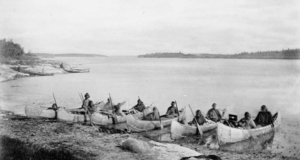The Use of Violence on the American Frontiers: Examining U.S.-Native American Relations in the 18th and 19th Centuries
By
2016, Vol. 8 No. 11 | pg. 2/2 | « The Nez Percé War of 1877The Nez Percé War was a direct result of the brewing combative relationship that had developed between the Nez Percé people, known as the Nimiipuu, and the U.S. in the decades prior to the war. The Nez Percé War meant different things to both the Americans involved as well as the Nimiipuu who migrated in search of sanctuary. For the Nez Percé, the war became an epic journey across the U.S. that pushed the members of the community to the brink of human endurance. For the U.S. troops, the war proved disastrous, humiliating, and without any satisfaction at the conclusion of the conflict.26 Although the conflict lasted less than a year, and had no great impact on the U.S., the Nez Percé War is known as the “last great Indian war” as no other conflict except for small scale skirmishes and raids occurred in the U.S. following the war.27 The conflict was the end of a bloody chapter in U.S. history that saw the U.S. expand across the North American continent at a cost to the independent Native American cultures that were seen as obstacles. As was the normal procedure between the U.S. and Native American tribes, the relationship between the Nez Percé and the U.S. slowly deteriorated over time. Prior to American contact, the Nimiipuu occupied land totalling around 13.5 million acres between the present day Washington-Idaho borders. It is estimated that this land had been occupied by the ancestors of the Nimiipuu for the past ten thousand years.28 The peaceful existence that the Nez Percé tribe lived came to an end around the middle of the nineteenth century when the U.S. finally expanded into the surrounding area. The first upheaval followed when Indian Agent Elijah White arrived in the early 1840s and instituted a hierarchy of authority within the tribal system. While the Nez Percé believed in the decentralization of authority to the individual tribe members, Mr. White forced the tribe to elect a single leader to speak for the entire tribe.29 Although this move did result in discontent among the tribe’s people, the Nimiipuu grudgingly accepted the restrictions put on them and their cultural beliefs. It was not until the Treaty of 1863 that the Nez Percé became angry and disillusioned towards the U.S. and the infringing actions that were being taken towards the Nez Percé tribe. When gold was found in river streams north of the Nez Percé lands in the early-1860s, a mass immigration of miners and settlers came into the region to find their fortune. Although the federal government was bound by past treaties signed with the Nimiipuu to protect their land from possible incursion by American citizens, the possibility of valuable gold-fields in the region resulted in the U.S. reneging on its duties for the possible gains to be had. In 1863, this led to a treaty that saw the Nimiipuu’s land taken away from them and the possible wealth of the gold under their past treaty protected land given away. The Nimiipuu were forced to give away over 90 percent of their land to the U.S. government, going from 6,932,270 acres to 748,996.30 The tribesmen were also cheated out of an estimated $3 Million in gold that was dug up from under their traditional land.31 Known as the “Cheat Treaty” among the Nez Percé tribe’s people, the betrayal of the U.S. government to prior treaties signed with the Nez Percé confirmed that the U.S. could not be trusted. A conflict became inevitable as the U.S. continued its gradual encroachment.War finally came about between the Nez Percé and the U.S. in 1877 when a small group of Nimiipuu went on a quest of revenge across the region against the settlers that had wronged them after members of the tribe came together to celebrate a Tel-lik-leen (a cultural ceremony trumpeting the triumphs of the past).32 Upon returning to camp after killing several individuals, the tribe was paralyzed over what action should be taken next. Understanding that there was no going back after what had just happened, the tribe united against the U.S. knowing that a peaceful solution to the crisis at hand was impossible. After garnering several victories early on in the conflict, the Nez Percé tribe was forced to flee their ancestral homeland and trek 1,500 miles across Oregon, Idaho, Montana and Wyoming.33 While the initial goal of the Nimiipuu was to survive, a decision was made by the chiefs of the tribe to attempt to find sanctuary in Canada. This decision was partly influenced by the past occurrences of Native American tribes finding sanctuary there, notably the Lakota and the Teton Sioux.34 For the rest of their trek, the tribe continually pushed north in the hope of making it to a sanctuary they believed was just ahead of them. Just under the 40-mile mark from the Canadian border, around Bear Paw’s Mountain, the Nez Percé were finally over taken by U.S. forces and forced to surrender after a brief siege.35 As a result of the Nez Percé War there was a change in perception that American’s held towards the Native American communities with which the U.S. had repeatedly found itself in conflict with across its frontiers. While the war was generally met with approval by western newspapers, and condemned by eastern newspapers, pro-war opinion began to change as the war progressed. The combination of the underdog status of the Nez Percé tribe, the brilliance of the chieftain’s military campaign, and the “civilized” manner in which the war was fought, where no scalps were being taken by the Nez Percé and civilians were not targeted, led to praise by newspapers for the Nimiipuu and a decrease in vocal anti-Indian outbursts by newspapers that had supported the war.36 Following the decisive end to the Nez Percé War many newspapers and reporters wrote articles in defence of the Nimiipuu and against the injustices committed by the American government towards a tribe that was deemed a staunch ally. Several periodicals of the day wrote about the U.S.’s long history with the Nez Percé tribe, and how they played a pivotal part in the success of the Louis and Clark Expedition of 1804 to 1806.37 By the end of the conflict, the Nez Percé War became one of the most unpopular wars ever fought by the U.S. against Native American tribes.38 As for the Nimiipuu, many of the tribe’s members were forced onto reserves while the chieftains that had survived the conflict were sent to prison and ultimately forced to live in camps set up away from the reservations in which the tribe found itself. While the war only lasted a few months, June to October, it became a significant event for Americans as it was a closing chapter in America’s quest to control the west. ConclusionWhile the Northwest Indian War, First Seminole War, and the Nez Percé War do not have any prima facie connection to each other, these three conflicts tell us a great deal about the Indian wars that the U.S. fought in during the Early Republic. Since the outset of its independence, the U.S. had adopted an aggressive policy towards the acquisition of land and natural resources that belonged to the aboriginal tribes that lived in the frontiers surrounding the U.S.’s domain. In both the Northwest Indian War and the Nez Percé War, the U.S. first attempted to take as much as possible through diplomatic means before finally engaging in military action to suppress any threats that arose to its hegemony. In the Northwest Conflict, the illegal actions taken by squatters and settlers to claim land in the frontiers were condoned by the U.S., but no significant effort was made to stop these actions or the retaliations taken to avenge raids by Native Americans. In the Nez Percé War, the U.S. federal government allowed the illegal immigration of settlers and miners into the Nimiipuu’s lands as they saw it could benefit U.S. interests in the region and would lead to the U.S. government having more control over the gold-rush taking shape. In contrast to these conflicts, the First Seminole War shows us what the outcome was when an individualistic General looked to conduct a war based on his own objectives. While the U.S. government did privately protest the conduct of the war, Jackson’s aggression towards the Native Americans was condoned by President Monroe because of the benefits that the end of the war brought the U.S. The annexation of Florida became more than enough of an incentive for President Monroe to allow such behaviour to go unpunished. In all three conflicts the Native American tribes rose up against the U.S. only when they had had enough of the U.S. and its intrusion into their lives and homelands. Ultimately all resistance towards the U.S. ended in failure and annexation of aboriginal land, land that was turned over for the benefit of American settlers. While there were some victories for the Indian tribes early on in the wars, the overall conclusion to these wars, and the many others fought throughout this time period, was that Native Americans were forced off their land and relocated to reserves from where they could be controlled and pacified. Once these wars were concluded, little resistance was offered by the aboriginal tribes as their spirits were crushed and continued conflict seemed like a futile prospect. Through the aggressive policies adopted by the U.S., Native American tribes that engaged in conflict with the U.S. found themselves in a struggle that meant life or death for their way of life and their culture. Tribes that lost to the U.S. were forced from their ancestral land and onto reservations shared by other tribes that submitted to the dominion of U.S. authority. For over a hundred years, ranging from the 1780s to the end of the 19th century, the U.S. government adopted a violent policy in regard to aboriginal tribes across its frontiers. Through the use of violence America was able to achieve its ‘Manifest Destiny’ and spread from coast to coast. ReferencesCalloway, Colin G. “We Have Always Been the Frontier: The American Revolution in Shawnee Country.” American Indian Quarterly 16, 1 (Winter 92): 39-52. http://library.mtroyal.ca:2208/ehost/detail/detail?sid=835ac041-e6ea-4... Cebula, Larry. “Filthy Savages and Red Napoleons: Newspapers and the Nez Percé War.” Pacific Northwest Forum, 1, 1 (1976): 3-13. Retrieved March 14, 2015. Feller, Daniel. “Catherine Prescott Lecture: The Seminole Controversy Revisited: A New Look at Andrew Jackson’s 1818 Florida Campaign.” The Florida Historical Quarterly 88, 3 (Winter 2010): 309-325. Flanagan, John K. “The Invalidity of the Nez Percé Treaty of 1863 and the Taking of the Wallowa Valley.” American Indian Law Review 24, 1 (1999/2000): 75-98. http://www.jstor.org/stable/20070622. Accessed March 14, 2015. Greene, Jerome. Beyond Bear’s Paw: The Nez Percé Indians in Canada. Norman: University of Oklahoma Press, 2010. Hatch, Thom. Osceola and the Great Seminole War: A Struggle for Justice and Freedom. New York: ST. Martin’s Press. 2012 Heath, William. “Re-evaluating ‘The Fort Wayne Manuscript’: William Wells and the Manners and Customs of the Miami Nation.” Indiana Magazine of History 106 (June 2010):158-188. Accessed on March 14, 2015. ___________. “The Morgan John Rhys Diary and the Treaty of Greenville.” Northwest Ohio History 80, 2 (Spring 2013): 148-164. Heidler, David S. “The Politics of National Aggression: Congress and the First Seminole War.” Journal of the Early Republic 13, 1 (Winter 1993): 501-530. Hurt, R. Douglas. The Indian Frontier 1763-1846. Albuquerque: University of New Mexico Press, 2002. Lakomaki, Sami. “Our Line: The Shawnees, the United States, and Competing Borders on the Great Lakes ‘Borderlands’ 1795-1832.” Journal of the Early Republic 34 (Winter 2014): 597-625. Retrieved March 14, 2015. Mahon, John K. “The First Seminole War, November 21, 1817-May 24, 1818.” The Florida Historical Quarterly 77, 1 (Summer 1998): 62-67. Miller, David W. The Forced Removal of American Indians from the Northeast: A History of Territorial Cessions and Relocations, 1620-1854. Jefferson: McFarland, 2011. Pearson, J. Diane. The Nez Percé’s in the Indian Territory: Nimiipuu Survival. Norman: Oklahoma Press, 2008. Pratt, G. Michael. “The Battle of Fallen Timbers: An Eyewitness Perspective.” Northwest Ohio Quarterly 67 (Winter 1995) 1: 4-34. Remini, V. Robert. Andrew Jackson and the Course of American Empire, 1767-1821. New York: Harper & Row, 1984. Rosen, Deborah E. “Wartime Prisoners and the Rule of Law: Andrew Jackson’s Military Tribunals during the First Seminole War.” Journal of the Early Republic, 28 (Winter 2008) 560-595. “The Nez Percé war.” The Friend; a Religious and Literary Journal (1827-1906), 51 (1877 Dec 29) 158. Retrieved from http://search.proquest.com/docview/91109241?accountid=1343 “Treaty of Greenville 1795 Wyandots, Delawares, Etc., (concluded August 1795).” Retrieved March 28, 2015. http://library.mtroyal.ca:2208/ehost/detail/detail?vid=2&sid=e9b4da52... Vandervort, Bruce. “Indian Wars of Mexico, Canada and the United States, 1812-1900.” New York: Routledge Taylor and Francis Group, 2006. West, Elliott. The Last Indian War: The Nez Percé Story. Oxford: Oxford University Press, 2009. Endnotes
Suggested Reading from Inquiries Journal
Inquiries Journal provides undergraduate and graduate students around the world a platform for the wide dissemination of academic work over a range of core disciplines. Representing the work of students from hundreds of institutions around the globe, Inquiries Journal's large database of academic articles is completely free. Learn more | Blog | Submit Latest in History |


















